ex2分为两个部分,第一个部分为线性的逻辑回归,第二部分则是非线性。
第一部分
数据集:
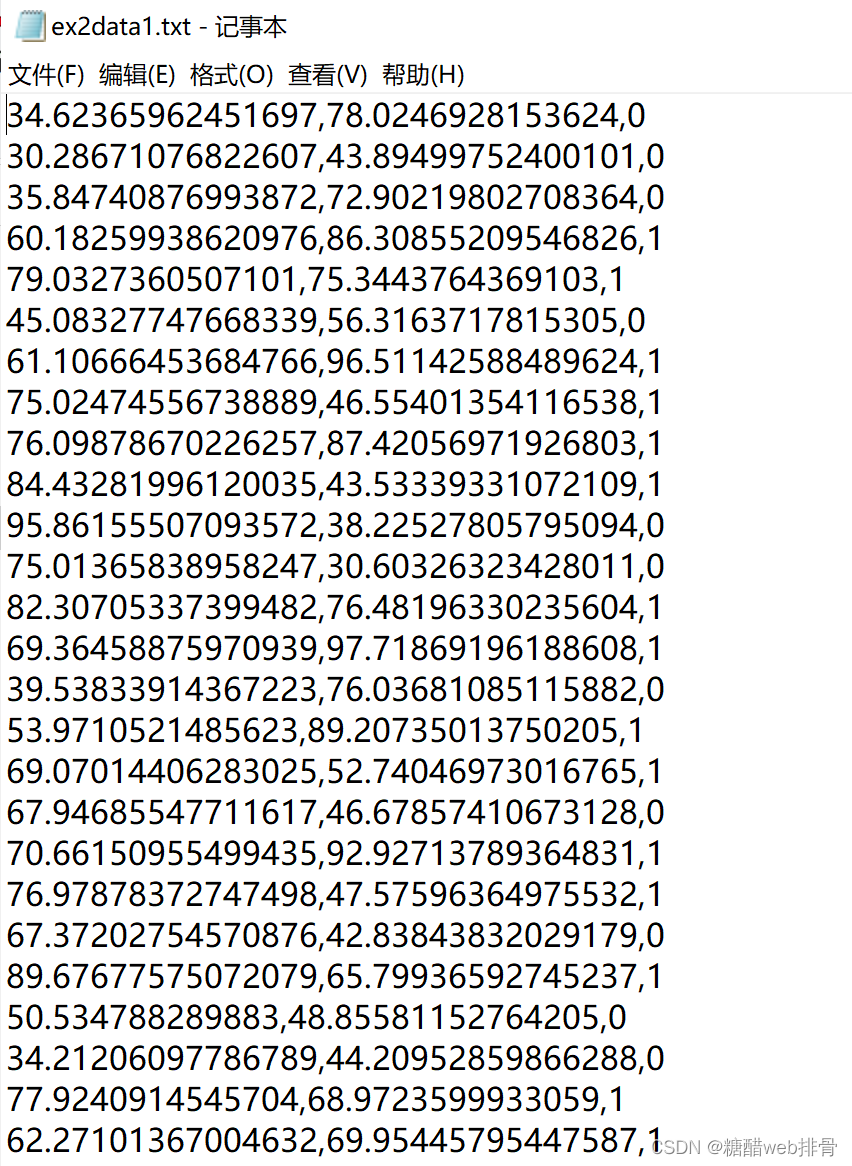
将图像画出来:
import pandas as pd
import numpy as np
import matplotlib.pyplot as plt
# 读取数据
df = pd.read_csv('ex2data1.txt', names=['x1', 'x2', 'y'])
df0 = df[df['y'] == 0]
df1 = df[df['y'] == 1]
# 画散点图
plt.scatter(df0.iloc[:, 0], df0.iloc[:, 1], c='b')
plt.scatter(df1.iloc[:, 0], df1.iloc[:, 1], c='r')
plt.xlabel('x1')
plt.ylabel('x2')
plt.legend('01')
plt.show()
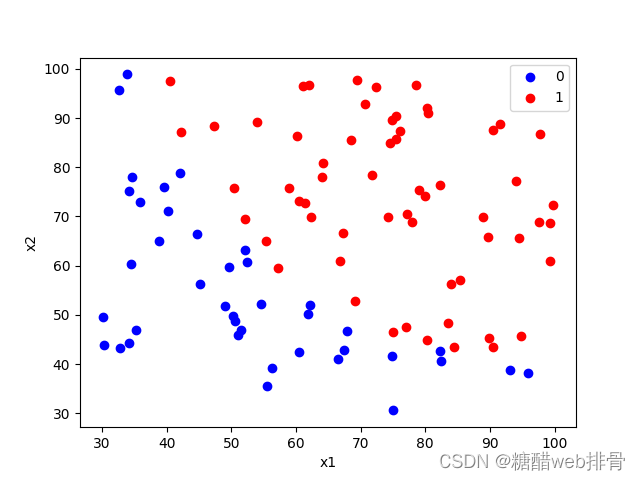
sigmoid函数为:
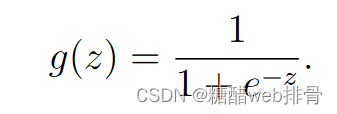
预测函数h(x)为:

代码实现:
def g(z):
return 1 / (1 + np.exp(-z))
def h(theta, x):
return g(np.dot(x, theta))Cost function:

def cost(theta, x, y):
theta = np.matrix(theta)
left = np.multiply(-y, np.log(g(x*theta)))
right = np.multiply((1-y), np.log(1-g(x*theta)))
return np.sum(left-right)/(len(x))下降梯度:

这里我先手动实现了梯度下降:
a = 0.01
for i in range(200000):
error = g(x * theta) - y
for i in range(3):
term = np.multiply(error, x[:, i])
theta[i, 0] -= a * np.sum(term) / len(x)经过200000次迭代,效果才比较好:

此时的theta和损失值为:
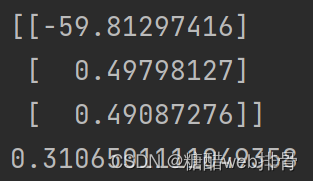
第一种方法源码:
import pandas as pd
import numpy as np
import matplotlib.pyplot as plt
# 读取数据
df = pd.read_csv('ex2data1.txt', names=['x1', 'x2', 'y'])
df0 = df[df['y'] == 0]
df1 = df[df['y'] == 1]
# 画散点图
plt.scatter(df0.iloc[:, 0], df0.iloc[:, 1], c='b')
plt.scatter(df1.iloc[:, 0], df1.iloc[:, 1], c='r')
plt.xlabel('x1')
plt.ylabel('x2')
plt.legend('01')
plt.show()
theta = np.matrix(np.zeros((3, 1)))
x = np.matrix(df.iloc[:, [0, 1]])
y = np.matrix(df.iloc[:, 2]).T
x = np.insert(x, 0, np.ones(len(x)), axis=1)
def g(z):
return 1 / (1 + np.exp(-z))
def h(theta, x):
return g(np.dot(x, theta))
def cost(theta, x, y):
theta = np.matrix(theta)
left = np.multiply(-y, np.log(g(x*theta)))
right = np.multiply((1-y), np.log(1-g(x*theta)))
return np.sum(left-right)/(len(x))
a = 0.01
for i in range(200000):
error = g(x * theta) - y
for i in range(3):
term = np.multiply(error, x[:, i])
theta[i, 0] -= a * np.sum(term) / len(x)
print(theta)
print(cost(theta, x, y))
px = [i for i in range(20, 100)]
py = [-(px[i] * theta[1, 0] + theta[0, 0]) / theta[2, 0] for i in range(len(px))]
plt.scatter(df0.iloc[:, 0], df0.iloc[:, 1], c='b')
plt.scatter(df1.iloc[:, 0], df1.iloc[:, 1], c='r')
plt.plot(px, py)
plt.xlabel('x1')
plt.ylabel('x2')
plt.legend('01')
plt.show()
还有另一种方法进行梯度下降,就是用scipy.optimize优化器来进行最优参数拟合,其余部分与第一种方法类似,多定义一个梯度下降函数,将梯度下降部分改为:
def gradient(theta, X, y):
theta = np.matrix(theta).T
X = np.matrix(X)
y = np.matrix(y)
grad = np.zeros((3, 1))
error = g(X * theta) - y
for i in range(3):
term = np.multiply(error, X[:, i])
grad[i, 0] = np.sum(term) / len(X)
return grad
result = opt.fmin_tnc(func=cost, x0=theta, fprime=gradient, args=(x, y))
theta = result[0]拟合效果非常不错:
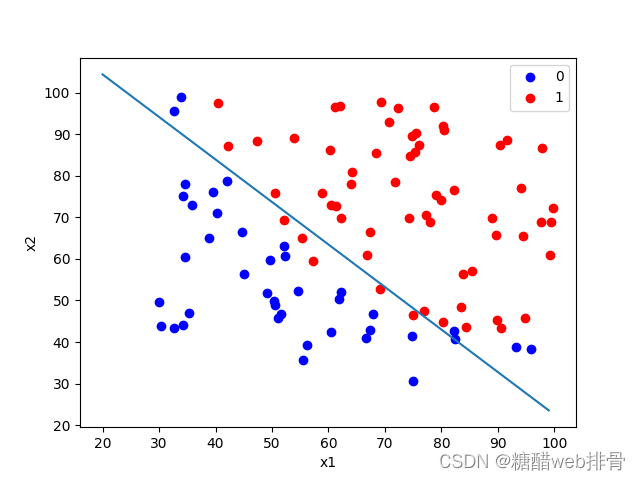
此时的theta与损失值为:

比第一种方法简直好太多。
第二种方法源码:
import pandas as pd
import numpy as np
import matplotlib.pyplot as plt
import scipy.optimize as opt
# 读取数据
df = pd.read_csv('ex2data1.txt', names=['x1', 'x2', 'y'])
df0 = df[df['y'] == 0]
df1 = df[df['y'] == 1]
# 初始化参数
theta = np.matrix(np.zeros((3, 1)))
x = np.matrix(df.iloc[:, [0, 1]])
y = np.matrix(df.iloc[:, 2]).T
x = np.insert(x, 0, np.ones(len(x)), axis=1)
def g(z):
return 1 / (1 + np.exp(-z))
def h(theta, x):
return g(np.dot(x, theta))
def cost(theta, x, y):
theta = np.matrix(theta).T
left = np.multiply(-y, np.log(g(x*theta)))
right = np.multiply((1-y), np.log(1-g(x*theta)))
return np.sum(left-right)/(len(x))
def gradient(theta, X, y):
theta = np.matrix(theta).T
X = np.matrix(X)
y = np.matrix(y)
grad = np.zeros((3, 1))
error = g(X * theta) - y
for i in range(3):
term = np.multiply(error, X[:, i])
grad[i, 0] = np.sum(term) / len(X)
return grad
result = opt.fmin_tnc(func=cost, x0=theta, fprime=gradient, args=(x, y))
theta = result[0]
print(theta)
print(cost(theta, x, y))
px = [i for i in range(20, 100)]
py = [-(px[i] * theta[1] + theta[0]) / theta[2] for i in range(len(px))]
plt.scatter(df0.iloc[:, 0], df0.iloc[:, 1], c='b')
plt.scatter(df1.iloc[:, 0], df1.iloc[:, 1], c='r')
plt.plot(px, py)
plt.xlabel('x1')
plt.ylabel('x2')
plt.legend('01')
plt.show()
第二部分
数据集:
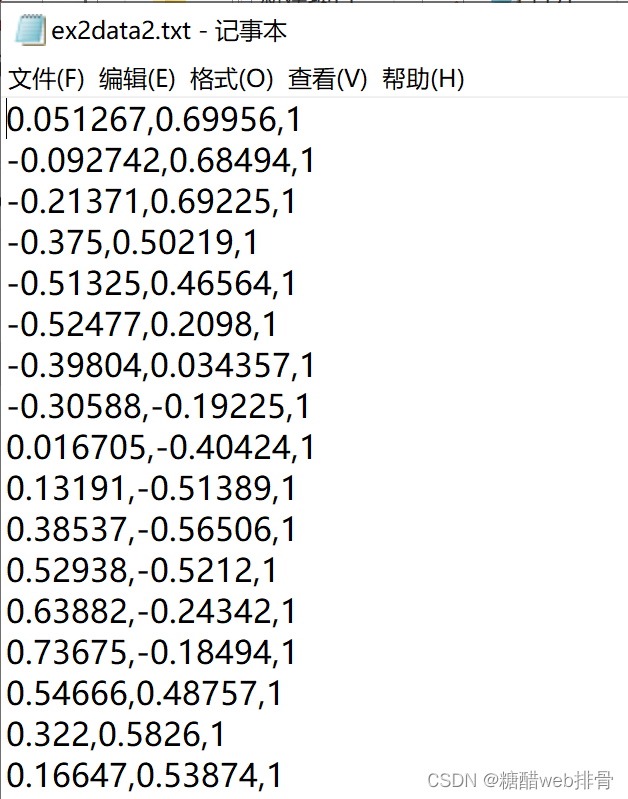
将其画为散点图展示:
import pandas as pd
import matplotlib.pyplot as plt
import numpy as np
# 读取数据
df = pd.read_csv('ex2data2.txt', names=['x1', 'x2', 'y'])
df0 = df[df['y'] == 0]
df1 = df[df['y'] == 1]
# 画散点图
plt.scatter(df0.iloc[:, 0], df0.iloc[:, 1], c='b')
plt.scatter(df1.iloc[:, 0], df1.iloc[:, 1], c='r')
plt.xlabel('x1')
plt.ylabel('x2')
plt.legend('01')
plt.show()
这里很明显是非线性的关系,查看说明文档发现需要构造特征为:
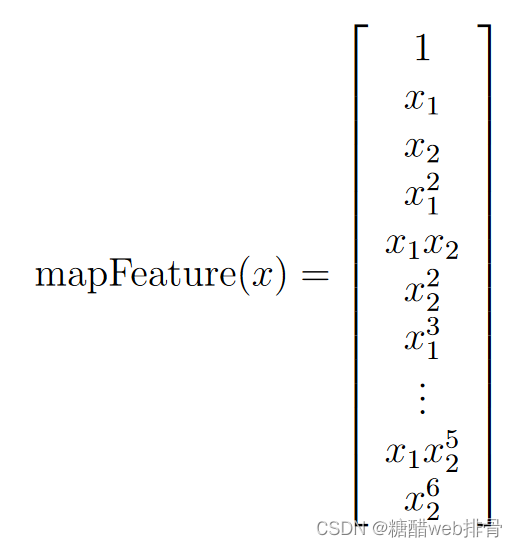
# 构造x
x = df.iloc[:, [0, 1]]
x1 = df.iloc[:, 0]
x2 = df.iloc[:, 1]
degree = 6
for i in range(1, degree+1):
for j in range(0, i+1):
x['F' + str(i-j) + str(j)] = np.power(x1, i-j) * np.power(x2, j)
x.drop('x1', axis=1, inplace=True)
x.drop('x2', axis=1, inplace=True)
x = np.matrix(x)
x = np.insert(x, 0, np.ones(len(x)), axis=1)然后和第一问一样,实现函数,但是注意这里的cost function要添加正则化项:

def cost(theta, x, y):
theta = np.matrix(theta)
first = -np.multiply(y, np.log(h(theta, x)))
second = -np.multiply((1-y), np.log(1 - h(theta, x)))
third = sita * np.sum(np.power(theta, 2)) / len(theta)
return np.sum(first + second) / len(x) + third 使用优化器进行优化求最优解():
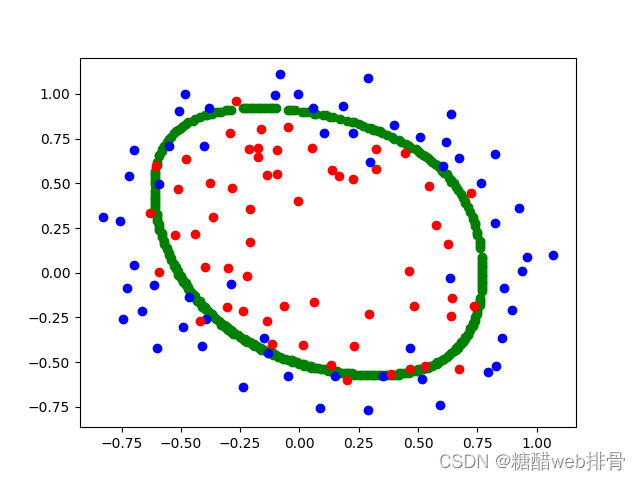
此时的cost为0.45801011485103144。进一步调低,此时结果为:
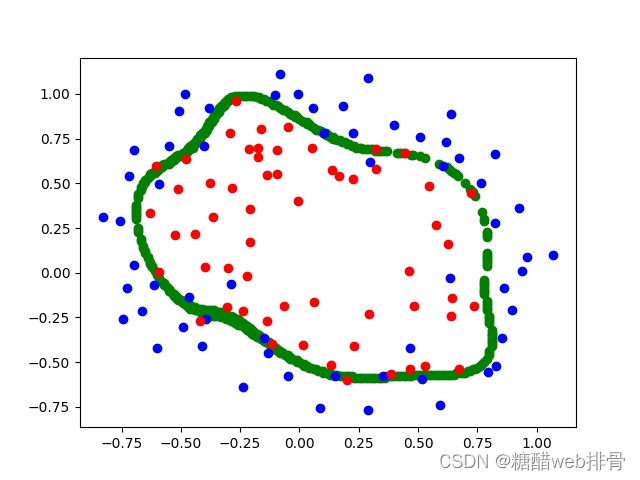
cost为0.26097691012426083。
源码:
import pandas as pd
import matplotlib.pyplot as plt
import numpy as np
import scipy.optimize as opt
# 读取数据
df = pd.read_csv('ex2data2.txt', names=['x1', 'x2', 'y'])
df0 = df[df['y'] == 0]
df1 = df[df['y'] == 1]
# 画散点图
plt.scatter(df0.iloc[:, 0], df0.iloc[:, 1], c='b')
plt.scatter(df1.iloc[:, 0], df1.iloc[:, 1], c='r')
plt.xlabel('x1')
plt.ylabel('x2')
plt.legend('01')
plt.show()
# 构造x
x = df.iloc[:, [0, 1]]
x1 = df.iloc[:, 0]
x2 = df.iloc[:, 1]
degree = 6
for i in range(1, degree+1):
for j in range(0, i+1):
x['F' + str(i-j) + str(j)] = np.power(x1, i-j) * np.power(x2, j)
x.drop('x1', axis=1, inplace=True)
x.drop('x2', axis=1, inplace=True)
x = np.matrix(x)
x = np.insert(x, 0, np.ones(len(x)), axis=1)
# 构造y
y = np.matrix(df.iloc[:, 2]).T
# 构造theta
theta = np.zeros(x.shape[1])
sita = 0
# g(z)
def g(z):
return 1 / (1 + np.exp(-z))
# h(x):
def h(theta, x):
return g(np.dot(x, theta.T))
def cost(theta, x, y):
theta = np.matrix(theta)
first = -np.multiply(y, np.log(h(theta, x)))
second = -np.multiply((1-y), np.log(1 - h(theta, x)))
third = sita * np.sum(np.power(theta, 2)) / len(theta)
return np.sum(first + second) / len(x) + third
print(cost(theta, x, y))
def gradient(theta, X, y):
theta = np.matrix(theta).T
X = np.matrix(X)
y = np.matrix(y)
grad = np.zeros((28, 1))
error = g(X * theta) - y
for i in range(28):
term = np.multiply(error, X[:, i])
if i == 0:
grad[i, 0] = np.sum(term) / len(X)
else:
grad[i, 0] = np.sum(term) / len(X) + sita * theta[i, 0] / len(X)
return grad
result = opt.fmin_tnc(func=cost, x0=theta, fprime=gradient, args=(x, y))
theta = result[0]
print(theta)
print(cost(theta, x, y))
x1 = np.arange(-1, 1, 0.01)
x2 = np.arange(-1, 1, 0.01)
temp = []
for i in range(len(x1)):
for j in range(len(x2)):
temp.append([x1[i], x2[j]])
temp = pd.DataFrame(temp)
x1 = temp.iloc[:, 0]
x2 = temp.iloc[:, 1]
xx = pd.DataFrame()
for i in range(1, degree+1):
for j in range(0, i+1):
xx['F' + str(i-j) + str(j)] = np.power(x1, i-j) * np.power(x2, j)
xx = np.matrix(xx)
xx = np.insert(xx, 0, np.ones(len(xx)), axis=1)
theta = np.matrix(theta).T
res = np.dot(xx, theta)
res = g(res)
px = []
x1 = np.arange(-1, 1, 0.01)
x2 = np.arange(-1, 1, 0.01)
for i in range(len(res)):
if abs(res[i, 0] - 0.5) < 0.04:
px.append([xx[i, 1], xx[i, 2]])
print(len(px))
for i in range(len(px)):
plt.scatter(px[i][0], px[i][1], c='g')
plt.scatter(df0.iloc[:, 0], df0.iloc[:, 1], c='b')
plt.scatter(df1.iloc[:, 0], df1.iloc[:, 1], c='r')
plt.show()




















 6565
6565











 被折叠的 条评论
为什么被折叠?
被折叠的 条评论
为什么被折叠?








